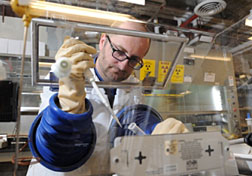- Number 374 |
- October 22, 2012
Using equations to mine nuclear energy resources

INL research scientist Peter Zalupski.
Rising energy demands and environmental concerns have intensified the search for valuable energy resources. As myriad public and private entities pursue increased efficiency, reliable renewable energy or unconventional fossil fuel reserves, a young researcher at DOE's Idaho National Laboratory is focused on recycling.
But INL research scientist Peter Zalupski is taking a modern approach to a mature idea. He's using mathematics and computational science in the quest to mine the most valuable resources from used nuclear fuel. His unique approach and early success recently earned him the 2011 INL Laboratory Director's Award for Early Career Exceptional Achievement, an honor reserved for researchers 35 and younger.
"Such significant accomplishments in this short period of time are very rare among senior researchers, and much more so for a young researcher such as Dr. Zalupski," Department Manager Jack Law said in his nominating letter.
Separations are hard to do
Recovering resources from used fuel relies on complex chemistry involving highly radioactive materials. Developing new approaches requires experimentation that is exceptionally challenging because of the materials involved. But Zalupski's research exemplifies INL's more fundamental approach to advancing the nuclear fuel cycle.
Specifically, one project aims to streamline development of new fuel recycling techniques by devising a computational model. The goal: mathematics that accurately predict how molecules behave in the complex chemical separations environment. Such a model would allow researchers to fine-tune new extraction processes before heading into the lab to test them.
“Twenty-first century computational science is becoming a powerful tool when predicting outcomes of aqueous separations,” Zalupski said. “Spent fuel is a very complex mixture; roughly one third of the periodic table is in there. What we’re looking to do is to come up with a way to computationally mimic that type of environment to be able to predict final destinations of uranium, plutonium and other actinides when we perform separations.”
Sorting a complex mixture
A simple cup of coffee can become fairly concentrated and complex as users add sugar and milk and cinnamon and creamer and Splenda and syrup. Imagine trying to extract a single ingredient — say, the sugar but not the syrup — to get a sense of the challenge facing chemists such as Zalupski.
Separations scientists aim to recover the actinide elements (such as uranium and plutonium) and leave behind the members of the lanthanide family, which capture neutrons and shut down the fission process. But actinides and lanthanides are chemically similar to each other and require complex chemistry to separate. Plus, the complicated, concentrated mixtures force molecules to behave in “non-ideal” ways that differ from behavior in more simple solutions.
"In order to predict where actinides go in a typical two-phase separation — whether they stay in the (watery) aqueous mixture or travel to the (oily) organic solution — you need to have a very, very good grasp on how to theoretically handle non-ideal solution behavior," Zalupski said.
He has partnered with two collaborators to develop a model that accurately describes such behavior. Simon Clegg, at England’s University of East Anglia, develops mathematical models. Zalupski is collecting experimental data, which Clegg feeds into the model and uses to refine and revise it. Laetitia Delmau at Oak Ridge National Laboratory is using a computational package called Solvent Extraction Fit (SXFIT) to test the accuracy of the model and its predictions.
“If we are able to prove that we can computationally predict with good accuracy, then we have this capability that we can use whenever a new separations scheme is proposed,” Zalupski said.
Expanding research
Similar approaches are used to analyze atmospheric chemistry and make climate predictions, but the effort to devise a nuclear fuel separations model is unique to INL. As the nation's nuclear energy laboratory, INL is distinctly qualified in advanced separations research and development. This project adds to the lab's existing separations capabilities and supports DOE’s mission to develop, test and ensure the reliability of advanced nuclear fuel cycles.
Such a computational capability could provide a powerful tool to accelerate and simplify development of advanced nuclear fuel recycling approaches. And Zalupski's accomplishments don't end there. He has published novel insights about the chemistry of two actinide elements: Americium and Curium. And he has initiated research related to the recovery of precious and rare earth metals, which have separations chemistry resembling that of nuclear fuel.
"Dr. Zalupski has had a very successful early career in the radiochemistry field that has led to numerous exceptional achievements," Law wrote in his nomination. "These achievements have established new capabilities at INL [and] enhanced the reputation of INL as the preeminent laboratory for nuclear fuel cycle research…. I believe these achievements for a young scientist with three years of experience at INL are truly exceptional."Submitted by DOE's Idaho National Laboratory
